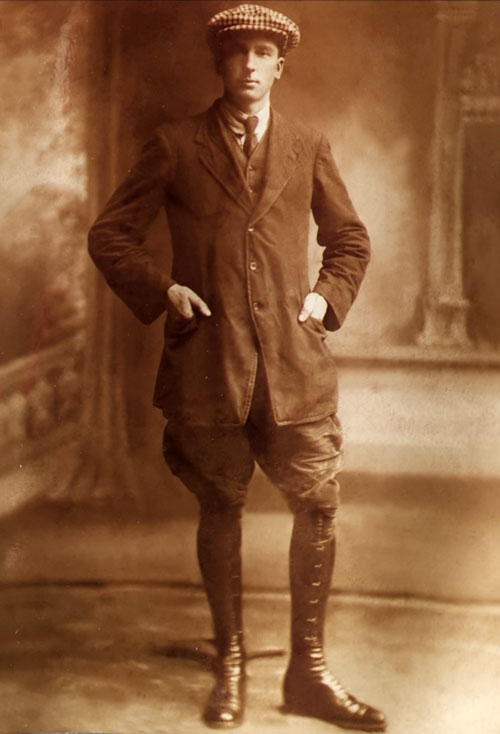Private David James Johnston

David James Johnston was born on 28 July 1896 at Ballyscullion, Bellaghy, County Londonderry, the first of six children of labourer (later yardman, coachman and domestic servant) James Johnston and his wife Matilda (née Macdonald). The family moved to Ballymena, County Antrim, in about 1910. By the time of the 1911 Census they were living in Mount Street, David working as a refreshment room messenger.
Johnston enlisted in the North Irish Horse between 6 and 8 November 1915 (No.1803 – later Corps of Hussars No.71568).
He embarked for France between 1916 and 1918, either with E Squadron on 11 January 1916, or with a later reinforcement draft for one of the five squadrons then in France and Belgium, probably A, D or E Squadron.
In May 1916 D Squadron came together with A and E Squadrons to form the 1st North Irish Horse Regiment, serving as corps cavalry to VII, XIX, then V Corps until February-March 1918, when the regiment was dismounted and converted to a cyclist unit, serving as corps cyclists to V Corps until the end of the war.
Johnston was wounded on 20 October 1918, during the Advance to Victory offensive. It appears that the wound was not severe enough to require a lengthy recovery, and on 25 January 1919 he was demobilised and transferred to Class Z, Army Reserve.
By 1926 Johnston was living at Coulter's Hill, Ballyclare, County Antrim, and working as a groom. He married Maggie Dorothy Esler on 16 December that year at Ballyclare.
I am grateful to Johnston’s daughter Mona and his grand daughter Ruth McCracken for providing the following story of his life after the war, and for providing the picture above, taken in the years after the war:
After the war Davey worked as a groom for Lieutenant-Commander Kenneth Clarke Kirkpatrick RN (brother of North Irish Horse officer J.C.G. Kirkpatrick), whose family were in the linen trade and owned a mill in Ballyclare. In the early 1930s he and his family moved with Kirkpatrick to County Down, living in one of Kirkpatrick’s houses on the Castlewellan Road, at a spot known as Kidd’s Corner. Davey's brother Bob (Kirkpatrick’s chauffeur), lived next door.
When World War 2 broke out, the price of horse feed jumped and Kirkpatrick reduced the number of horses he owned. Reluctantly Davey was let go, though Bob kept his job. While he looked for further employment, the family was split up. Davey’s wife and daughter went to live with his mother-in-law in Ballyclare, while he and his son stayed with his mother in Ballymena. The family were reunited when Davey found work teaching riding at a Girls’ School in Milford, County Armagh, in the early 1940s. The school eventually split in two, part of it moving to Wood Lodge in Castlewellan before closing down. The family then moved to Annsborough, a small village just outside Castlewellan.
When the school closed, Davey worked for a few years as a groom for Lord Annesley, who lived at Castlewellan Castle. He lost his job when a horse broke his leg, leaving him unable to work. At that point, in the late 1940s, Miss Cynthia Forde, sister of Colonel Forde of Seaforde, was looking for a groom, so the family moved to Seaforde, first in a tied house on the estate, and then in one in the village. Davey continued to work at Fordes until he retired in about 1960.
The family continued to live in Seaforde for a while. Davey’s daughter Mona married Annsborough man Bryans McCracken at Seaforde church in 1952. In the late 1960s Davey and his wife came to live in Newcastle, briefly with his daughter when Maggie was ill, then moving into a pensioner’s bungalow on the Castlewellan Road in the early 1970s. Maggie died in 1975, Davey in 1977.
Davey’s love of horses never waned. He watched the horse racing whenever he could on the television. Indeed Commander Kirkpatrick had a fairly successful racehorse called Masterpiece, which Davey helped to train.
